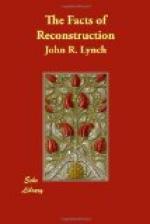While seated at my desk one day a messenger from the White House made his appearance, and I was informed that the President desired to see me in person. When I arrived at the White House I was immediately ushered into the President’s private office, where he was seated alone at a desk engaged in reading a book or a magazine. It was at an hour when he was not usually accessible to the public. He received me in a very cordial way. He informed me that there was an important matter about which he desired to talk with me—to get the benefit of my opinion and experience. He assured me of his friendly interest in the colored people. It was his determination that they should have suitable and appropriate recognition under his administration. He said he was very much opposed to the color line in politics. There was no more reason why a man should be opposed or discriminated against on account of his race than on account of his religion. He believed it to be the duty of the Democratic party to encourage the colored voters to divide their votes, and the best way to do this was to accord to that race the same relative consideration, the same treatment, and to give the race the same recognition that is given other races and classes of which our citizenship is composed. The party line is the only one that should be drawn. He would not appoint a colored Republican to office merely for the purpose of giving official recognition to the colored race, nor would he refuse to appoint a colored Democrat simply because he was colored. If this course were pursued, and this policy adopted and adhered to by the Democratic party, the colored voters who are in harmony with that party on questions about which white men usually divide, could see their way clear to vote in accordance with their convictions upon such issues, and would not be obliged to vote against the party with which they may be in harmony on account of that party’s attitude towards them as a race. “In other words,” he said, “it is a well-known fact that there are thousands of colored men who vote the Republican ticket at many important elections,—not from choice but from what they believe to be a necessity. If the views entertained by me on this subject should be accepted by the Democratic party, as I hope and believe they will be, that necessity,—real or imaginary,—would no longer exist, and the gradual division of the colored vote would necessarily follow.”
He went on to say that he had not hesitated to express himself fully, freely and frankly with members of his own party on the subject, and that he had informed them of the course he intended to pursue; but that he had been advised against appointing any colored man to an office in which white women were employed.




